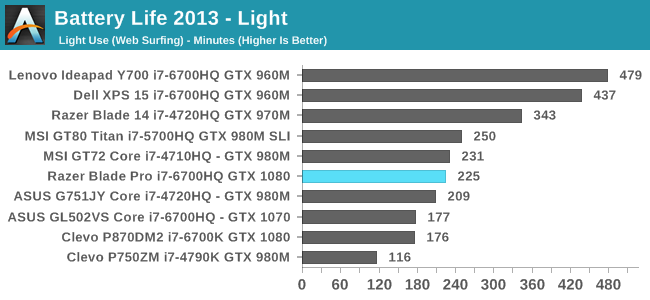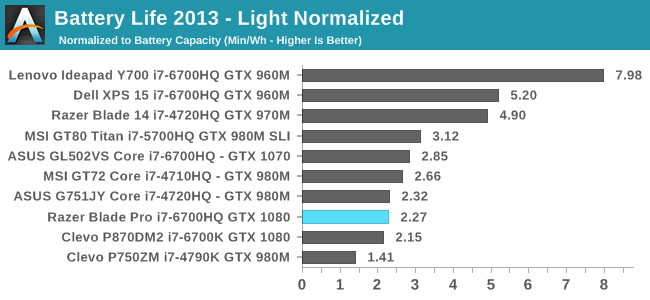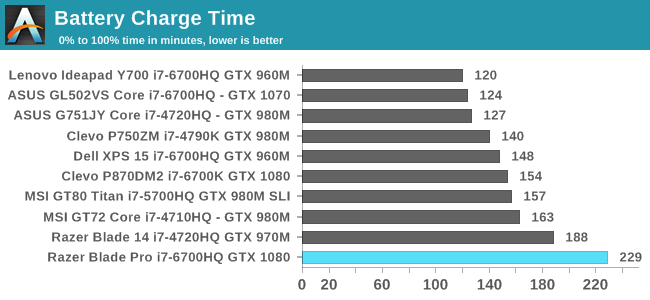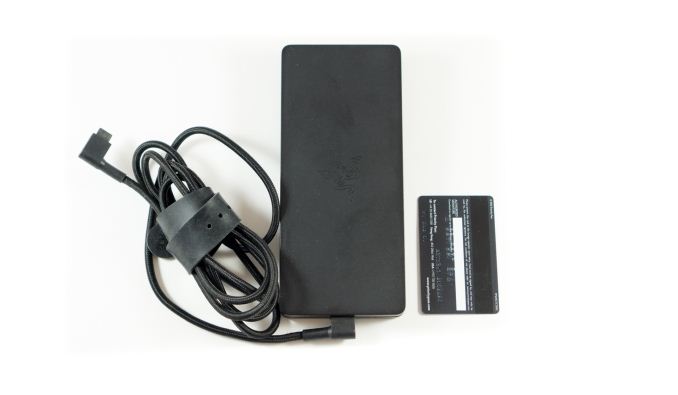The 2016 Razer Blade Pro Review
by Brandon Chester on March 6, 2017 8:00 AM EST- Posted in
- Laptops
- Razer
- Razer Blade Pro
Battery Life
It's fairly well established at this point that gaming laptops and other desktop replacement machines act more like highly portable all-in-one computers than laptops. That is to say, the battery life that you can expect when really making use of the laptop's hardware is incredibly short. With that being said, there's no reason why a gaming laptop shouldn't be able to offer decent battery life for lighter tasks like surfing the web and watching videos. Due to the static power consumption of the system it's unlikely to achieve the same sort of battery life that an ultrabook would, but users should at least be able to do web surfing or get through a movie before having to recharge.
To characterize the Blade Pro's battery life in these types of situations I've run it through our two web battery tests and our video playback test. As always, the display was set to 200 nits in order to keep results comparable between devices. To ensure consistency with the experience that other Blade Pro users will have, the testing was done using Razer's included color profile rather than the more accurately calibrated profile that I generated for the review, as the different appearance for each profile can have an impact on the power consumption if power-saving measures like content-adaptive backlight controls are utilized.
2013 Light Battery

In the old 2013 battery test the Blade Pro comes in at 225 minutes, which is 3.75 hours, or 3 hours and 45 minutes if you prefer that form. This is right in the middle of the chart, but if you compare it to other laptops that use GTX 1070 and GTX 1080 you'll find that it actually leads by a significant margin. A slightly unfair but relevant comparison is to the Clevo P870DM2, which is a desktop replacement machine that is considerably larger and heavier, but also has a desktop i7 CPU and a smaller battery. The Clevo lasts just under three hours, so the Blade Pro has an advantage if you're looking for an incredibly powerful laptop that can be used for some time off of a charger.
2016 Web Battery

In the newer 2016 web browsing test the Razer Blade Pro lasts almost exactly as long as in the older 2013 test. This would suggest that the additional workload of the newer web test is not really relevant next to the static power consumption of the laptop, and if that is the case, users should be able to expect similar battery life for all lightweight tasks.
Normalized Battery Life


While not directly relevant to consumers, it's interesting to look at a device's battery life as a function of its battery capacity in order to get an idea of how efficient it is. As you can see, while the Blade Pro does last longer than the Clevo P870DM2 in our web browsing tests, it did so with the help of a larger battery, and the normalized battery life relative to the capacity of the battery is very similar. It's worth noting that the Blade Pro achieves this with a UHD display, while the Clevo was tested with a 1080p panel, and so I would argue that Razer's result is the more impressive of the two. Of course, the Clevo is disadvantaged by using a desktop CPU, but being able to scale down power for light workloads is necessary for a laptop.
Tesseract Score


In our video playback battery test the Blade Pro comes in at 3.88 hours, which is ever so slightly longer than the web tests which clocked in around 3.75 hours. This is a pretty solid confirmation that the Blade Pro's battery life will be consistent for all these light workloads, as the additional power consumption of a lightweight task is small relative to the fixed platform power of the laptop. As for the Tesseract score, the Blade Pro can't last long enough to get through two cycles of a 143 minute movie, which is a fairly standard length for a movie nowadays, so I'd recommend keeping the power supply handy.
Based on these tests, one can conclude that the Razer Blade Pro provides between three and four hours of battery life for general lightweight tasks like web browsing and watching videos. Razer isn't able to take advantage of Optimus because of the inclusion of G-SYNC, so you're always running off the GTX 1080. With heavier workloads that make greater use of the GPU I've found that the battery depletes rapidly, so I don't recommend trying to play a game without the laptop being plugged in. However, having four hours of battery life is honestly not that bad for such a high performance machine, and it compares favorably to desktop replacement machines from other vendors because, in addition to lasting longer, the total mass of the Blade Pro and its power supply is still much less than a DTR from Clevo or MSI on its own.
Charge Time
The 2016 Razer Blade Pro comes with a 250W power supply, and given that you can only expect a few hours of usage at best, it's one that you'll want to keep with you. Thankfully, it's not incredibly thick like the power supply for Clevo laptops, so it can fit into the inner pockets of many bags without much difficulty. It is still relatively heavy compared to something like Apple's 85W MacBook charger though, so it's a good idea to take it into consideration when deciding whether you want to carry the Blade Pro somewhere.

The Blade Pro has a 99Wh battery which is the biggest battery Razer could ship while complying with airline regulations. With such a large battery and a 250W PSU, the charge time is naturally going to be longer than something like the Clevo P870DM2 which only has an 82Wh battery and a 330W PSU. Having actually used Clevo's power supply, I will say that Razer's solution is basically half the size and mass, and I think that having a slightly longer charge time is worth it to avoid further increases to the mass of the laptop + PSU combo. You can see the size of the Blade Pro charger in the image above, with a credit-card sized card for reference. Additionally, you'll almost always have the Blade Pro plugged in anyway, so a slightly longer-than-average charge time really doesn't present a real-world problem.











57 Comments
View All Comments
fanofanand - Monday, March 6, 2017 - link
I bought my wife a cheap $350 Acer (because she doesn't know the difference) and despite her repeated attempts, she has been unable to destroy it. Plastic is not premium, but is great when you are building things to a price point. Most consumer electronics sold are not the top-end gear.BrokenCrayons - Monday, March 6, 2017 - link
I think the part I don't like about plastic laptops are those metal-in-plastic screw fittings where there's a little threaded cylinder for the screw that has that knotty outside and get stuffed into a hollow plastic tube. (No idea what the technical name for those things are.) The plastic sometimes will crack around them and the screws along with the threaded cylinder thingies will break free.Barilla - Monday, March 6, 2017 - link
Ok, just to clarify - I have no issue with this laptop being made of aluminium, I even agree it's a good choice, although if I wanted to be picky, there are carbon fibre materials with thermal conductivity equal to or higher than aluminium.I meant it on a more general level as your comment about carbon fibre mentioned Dell XPS, which in it's 13" version houses a 15W CPU and no dGPU, which means it needs to dissipate at most 1/10th the heat this laptop does.
Really, nothing against aluminium. Or magnesium either, as I'm typing this comment from a Surface. All I'm saying is that plastic, and especially carbon fibre, is a perfectly fine material in many - not all - applications, including some laptop and smartphone chassis.
Peace.
Azurael - Monday, March 6, 2017 - link
I wonder whether people will ever get beyond that 'it looks more premium' mindset with CFRP (or even polycarb) vs. metals. Personally, I'd prefer to be able to buy 'plastic' versions of any portable electronics for impact resistance, metal devices are far too easy to dent and break. It's all very well having a metal phone or laptop, but if you have to keep it in a plastic/rubber case all the time to keep it safe, I don't see the point.simonm - Monday, March 6, 2017 - link
Carbon fibre is strong but to the best of my knowledge not usually a good conductor of heat except for certain specialised versions.So unless Razer went with some kind of super carbon fibre the case won't be able to facilitate cooling (like an extended heat sink) as well as if it were aluminium. I doubt Razer did use a high conductivity fibre or they'd be marketing the hell out of that.
Instead they chose it probably for its high strength/rigidity to weight ratio, lower cost than aluminium and marketing because it sounds cool and high end.
If money (and weight) wasn't an option you could use lots of metal alloys that are more conductive than aluminium. Copper... gold ;)
simonm - Monday, March 6, 2017 - link
Correction: change option to issue!PS: So I think most people are looking down on the CF for its thermal properties when compared with aluminium. Aluminium offers good weight and thermal properties but with high expense and lower hardness/rigidity than carbon fibre.
With a 1080 packed in there and a 180 W power adapter I reckon you'd want as much help dissipating heat as you can get. So carbon fibre seems like something of a compromise.
colonelclaw - Monday, March 6, 2017 - link
Surely carbon fibre is much more expensive than aluminium? That's the impression I always got from products that use it, or is that just marketing?fanofanand - Monday, March 6, 2017 - link
Carbon Fiber (the high-tech variety) is far more expensive than aluminum.Bullwinkle J Moose - Monday, March 6, 2017 - link
if money (and weight) wasn't an option.....Diamond plated Silver would be a far better thermal conductor than Copper or Gold
Diamond has 3X the thermal conductivity of even silver
But a diamond frost coat on copper would look better
A Rose Gold that costs as much as real Gold
Sound like an Apple Product!
SkipPerk - Wednesday, April 19, 2017 - link
In order to plate the silver to make it strong enough I think it would interfere with the thermal transfer. I think nickel-plated copper would be the better choice, although it would still be soft. Aluminum really is the best choice.